Stellar XLM Digital Asset Report: Review And Investment Grade

Share this article
Stellar XLM Digital Asset Report: Introduction
Stellar is a scalable distributed ledger technology with primary applications for payment transactions, trading, and distributed applications. While the project is often seen as a B2C alternative to Ripple, it is other use cases, such as the decentralized exchange, that will likely determine if Stellar succeeds or fails in the long-run.
When it comes to the team behind the project, Stellar has a troubled past that raises uncomfortable questions about its leadership. There are also concerns around centralization and governance of the network.
However, the fast pace of development and adoption, in addition to a high level of awareness and community support within the cryptosphere, make it one of the frontrunners in the blockchain infrastructure race.
With that said, Stellar needs to do more in the dApp space in order to remain competitive with other comprehensive solution projects. Its low level of use case implementation enables competitors to strengthen their network effect.
Part One: The Business Case
Stellar Market Opportunities
Stellar has the potential to disrupt several markets. As a payment solution, it can make an impact in the digital global remittance space, expected to grow to over $8.5 billion by 2025, and the contactless payment space, expected to grow to $801.4 billion in value by the same year. With over 65% of the world population having a bank account, capturing a piece of this market represents a substantial opportunity for growth.
It could also provide a solution for the 1.7 billion unbanked people around the globe, through its partnerships with popular remittance services such as Tempo and Coins.ph.
Stellar’s decentralized exchange solution makes the network a player in the crypto trading space as well. Today, trading in the crypto industry is still dominated by centralized exchanges. Total trading volume has crossed the $11 billion mark and number of crypto wallet holders has topped 28 million, making this a significant opportunity for DEX solution providers.
With use of gateways and token creation, Stellar could also penetrate traditional asset markets. This would be a much larger playground, as the total value of the global stock market alone was valued at over $77 trillion in 2017. Just in the US, an average of 18.7% of taxpayers across the country directly own stocks.
Last, but not least, Stellar enables the creation of smart contracts and the development of dApps on the network. The top ten Ethereum dApps, according DappRadar, can reach a 7-day volume of over 79,000 ETH. At a price of $204 per ETH, this puts the figure of 7-day volume at over $16 million, which projects to over $830 million over the course of a full year. As the industry grows, those number will also continue to grow.
Consider that worldwide mobile application revenue is projected to be around $188.9 billion in 2020. The dApp space could, in time, become similarly vibrant.

Number of new dApps per month, per Stateofthedapps.com
Stellar is bound to face stiff competition in each one of its target market segments. Below is a table representing some of the key competitor projects.
| Project Name | Ticker | Launch Date | Key Features | Market Cap |
| Stellar | XLM | Started 2014;
SCP Upgrade 2015; |
-FBFT consensus;
-1000 op/sec; -3-5 sec confirmation; -DEX; -Starlight; -non-Turing Complete smart contracts; |
$4.331 billion |
| Dash | DASH | Started 2014;
Rebranded 2015; |
-PoW consensus;
-PrivateSend; -InstandSend; -Infrastructure – POS, ATMS, merchant partnerships; |
$1.128 billion |
| Waves | WAVES | Mainnet launch 2016; | -LPoS consensus;
-100 tps; -DEX; -smart contracts; -payment gateways; -simple token creation; |
$0.147 billion |
| Ethereum | ETH | Started 2014;
Frontier launched 2015; |
-PoW consensus;
-Turing Complete smart contracts; -biggest dApp ecosystem |
$18.201 billion |
User and developer adoption will determine the winner among the blockchain network projects. While Ethereum has a big lead in terms of dApps, it is not insurmountable, especially given the negative press it has received around scalability issues.
Dash and other competitors have a lead in the payments and remittance space, but no single player has yet gained widespread adoption; in this particular case, Stellar’s use of Anchors as trusted issuers of credit and deposits gives it a natural market penetration angle.
Finally, the DEX space is still in its infancy as it struggles to compete for volume with centralized exchanges. Here, its brand recognition and low-cost structure should give it a leg up versus existing players like 0x protocol.
The NVT comparison suggests that Stellar investors are buying into the growth story. Its on-chain transactions can be priced 20-30 times higher than the next competitor, Waves. However, without growth of adoption this unicorn will vanish like any other in-a-bubble project.
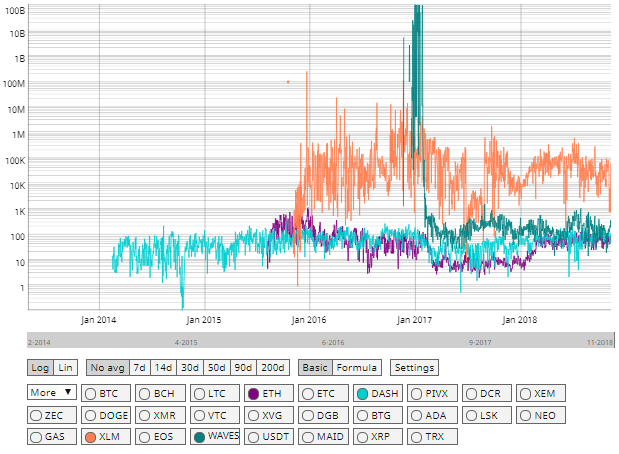
Stellar is also likely to face pressure from incumbents, who will innovate and use networking effects to defend their market shares. Coinbase is listed here as a representative of a more traditional exchange and custodial services company, despite being a crypto industry player.
| Company Name | Ticker | Competing Product | Key Features | Market Cap |
| Western Union | WU | Money transfers | -200 countries;
550,000 agent locations; – 150,000 ATMs, Kiosks; |
$8.218 billion |
| Visa | V | Electronic payments network | -Debit/credit cards;
-near 1700 tps -merchant, transaction and processing infrastructure; |
$310.127 billion |
| Coinbase | n/a | GDAX | crypto-fiat pairs;
regulated; custody services; |
$8 billion (not publicly traded) |
The biggest threat to Stellar here is the fact that these companies have consistent revenue, and an established user base. If one of them decided to offer its own crypto solution, its path to adoption would consequently be much shorter through the migration of an existing user base to the new product.
It should also be noted that industry giants like Visa and Mastercard are filing patent applications and establishing partnerships that could position them to be major players in the blockchain industry, posing the risk for a huge increase in competition from established players.
Each of the three sectors that Stellar is bound to affect, on their own, presents an attractive market opportunity, and together could offer extraordinary value.
Furthermore, the different components of the Stellar ecosystem have synergies, such as the use of DEXs for facilitating cross-border transactions. However, since Stellar is not a niche use-case network, it will inevitably require commercial partnerships in a dApp ecosystem to ensure adoption. If Stellar cannot quickly build a usage-driven ecosystem at pace with the market, it will see its position eroded by both crypto and traditional industry players.
Stellar Ecosystem Development
As with most common DLT architectures, nodes form the skeleton of the Stellar network. The system supports four types of nodes: watchers, archivers, basic validators and full validators. The archiver and full validator nodes record the history of the network. The basic and full validator nodes vote on the network.
From an ecosystem perspective, the key to the node structure is that any user can set up a validator node and become an active participant in the network.
Anchors
Capital flow across the network is achieved by means of a credit system. Stellar utilizes Anchors, which are trusted entities who issue credit and keep deposits safe on the network. This provides fiat on/off ramps for the users and facilitates cross-border payment transactions. Examples of such entities could include remittance service providers integrated with the Stellar network. While this adds a lot of convenience to the network, it also makes Stellar reliant on centralized actors, which runs counter to the fundamental principles of DLT networks. Conversely, the inclusion of such actors in the network makes the project more attractive and accessible from the standpoint of commercial integration than competitors.
StellarX DEX
Credits are traded using a decentralized exchange, which is one of the key infrastructure components of the network. A key differentiating factor of a DEX is that it allows a user to always maintain full control of his/her funds. With concerns about hacking attacks and a general focus on greater decentralization, the DEX has become one of the industry’s unicorn projects. However, DEXs have been plagued by liquidity, latency and cost issues. FBFT enables Stellar to process orders faster and cheaper than Ethereum-based alternatives. With the release of StellarX in September of 2018, Stellar gives traders hope for a competitive decentralized exchange.
Starlight
The recent release of the Starlight demo offers a look at Stellar’s version of payment channels. With the Lightning network’s popularity as a potential scalability and latency solution, this release ensures that Stellar’s users have all the comparable tools they could find on other networks, which is likely to increase adoption and user retention.
Horizon
The overall focus on usability is also very important, as ease of use and development plays a significant factor in the growth of the community. From this perspective, Horizon, which simplifies submitting transactions, checking account balances and subscribing to event streams, in addition to Starlight and StellarX, all represent major breakthroughs for the project.
ICO deployment
Stellar also offers users an ICO solution and smart contract functionality. While Stellar only supports basic smart contracts, it enables users to create and distribute tokens. This could make the network an attractive option for projects looking to launch asset-based products. In this regard, Stellar is more similar to Waves than Ethereum.
However, Stellar’s application ecosystem appears to be shallow for now, with Mobius ICO and Smartlands STO being the notable exceptions. The lull in the ICO market and the lack of an existent vibrant dApp ecosystem could prove to be serious obstacles for Stellar as competition for users and developers intensifies. However, the possibility of a pivot to STOs could help catalyze growth, if Stellar sees more utilization in this realm.
Organizational structure
From an organizational perspective, the development of the ecosystem is championed by two entities; the Stellar Development Foundation and Interstellar. The first was formed in 2014 to be responsible for, among other things, developing and maintaining the Stellar network and protocol, driving adoption, guiding the ecosystem and distributing lumens.
The Stellar Development Foundation conducts the Stellar Build Challenge, rewarding teams of chosen projects with lumens. It has also set up the Stellar Partnership Grant Program, which awards up to $2 million in funding to organizations that provide products and services vital for the network.
The network has had some success making friends. Stripe has been a major supporter. In fact, the payment startup provided initial funding for the Stellar Development Foundation in the form of a $3 million loan, which was repaid with 2 billion lumens.
Since, at its core, Stellar is an infrastructure project, it needs partners to help drive adoption. Companies like IBM have enough corporate weight to be able to push through necessary deals and facilitate implementation. Support and cooperation from such well-established entities, IBM in particular, represent crucial milestones that offer a much brighter outlook for future products built on Stellar that utilize the vast resources of such entities to quickly scale.
In 2017, the Stellar Development Foundation set up a for-profit entity, called Lightyear, to build essential development tools, in addition to helping anchors and companies with integration and operation on the network. After the recent acquisition of Chain, Lightyear was renamed to Interstellar.
It is noteworthy that Interstellar is behind the development of StellarX and Starlight, given that these are some of the most important infrastructure projects in the ecosystem. In this way, Interstellar appears to be very similar to Ripple Labs.
Considering the difficult history between Stellar and Ripple, and Stellar’s efforts to highlight their differences, it is curious how many similarities the two networks share.
In terms of community involvement, Stellar holds up quite well to the competition. However, actual adoption levels appear to be low in comparison.
| Project Name | Ticker | On-chain Txs | Reddit subscribers/ Twitter followers/ Facebook likes | Active Addresses |
| Stellar | XLM | ~1,000 | 96,516/254,294/19,607 | ~500 |
| Dash | DASH | ~9,000 | 23,035/317,768/35,562 | ~40,000 |
| Ethereum | ETH | ~550,000 | 401,908/433,646/141,421 | ~250,000 |
| Waves | WAVES | ~3,000 | 56,220/130,463/73,710 | ~10,000 |
There is a lot of excitement surrounding the different components of the Stellar network, but user engagement remains timid as reflected above.
StellarX could end up being a catalyst for the ecosystem, but at the moment Stellar is behind its rivals when it comes to building networking effects and will require more time to acquire users.
However, the community is vibrant enough to sustain the growth phase, and the corporate connections appear strong enough to help facilitate adoption. The overall takeaway is that Stellar needs to do a better job of converting excitement among its large number of community supporters into active users and developers.
Stellar Token Economics
Lumen (XLM) is the native currency of the Stellar network. It has several applications within the ecosystem but is primarily used as a payment instrument.
Payment and Remittance – the Stellar network focuses on improving the speed and efficiency of payment transactions. Use cases include prototypes from Deloitte, Tempo and Parkway.
Cross-currency – Lumens can be used as a cross-currency to convert between other currencies. This is especially useful for cross-border transactions. Users can send and withdraw local fiat currency through Anchors.
Fees – The base transaction fee on the network is 0.00001 XLM. A transaction can be comprised of several operations. The total transaction fee equals: # of operations * 0.00001 XLM. The fees are later redistributed in the network with the inflation lumens.
Staking – Stellar accounts have to maintain a minimum balance calculated as follows: (2 + # of entries) * base reserve. The base reserve is 0.5 XLM, and entries can be, but are not limited to: trustlines, offers, signers, data entries.
Speculation – Stellar is traded on many of the popular crypto-exchanges.
Tokens – Stellar supports the creation of tokens and ICOs on its platform, which enables projects to issue their own assets within the network’s ecosystem.
In 2014, Stellar created 100 billion stellars, as the coins were then called. In 2015, the coins were renamed to lumens. There is a fixed inflation rate of 1% per year. The Stellar Development Foundation is required by its mandate to give away the originally created lumens according to the following plan:
- 50% via the Direct Sign-up Program;
- 25% via the Partnership Program;
- 20% via the Bitcoin Program;
- 5% to be held by Stellar Development Foundation for operational costs.
At this point, there are over 104 billion lumens, of which over 8.6 billion have been given away, and over 18.89 billion are not held by the foundation. 2 billion are thought to be held by Stripe.
Of the remaining 16.89 billion, over 8.2 billion, or nearly 49%, are held by just 4 accounts. The highly concentrated nature of the coin supply and the stake-based voting methodology, adopted for the distribution of fee and inflation capital, reinforces the stigma of centralization often associated with the network.
This issue is further compounded by the fact that inflation and fee lumens are redistributed according to a stake-based vote. This mechanism, in theory, could further cement centralization as node operators are able to redistribute lumens to themselves. A high level of centralization introduces additional risk to the project, which investors like Morgan Creek Digital see as enough of a reason to exclude XLM from its funds.
| Project Name | Ticker | UIA | Key Uses | Total Supply |
| Stellar | XLM | Yes | -payment;
-tokens; -dApps -DEX; |
104.44 billion |
| Ethereum | ETH | Yes | -payment;
-tokens; -dApps; |
120.2 million |
| Dash | DASH | No | -payment; | 21.3 million |
| Waves | WAVES | Yes | -payment;
-tokens; -dApps -DEX; |
100 million |
Relative to its competition, Stellar has the biggest total coin supply; coupled with a high level of network centralization, this magnifies the risk of potential inflation events. The staking component of the network is not significant enough to create a deflationary effect. Further, the token is not tied to the consensus protocol and transaction fees are calculated based on a base fee model. This means there won’t be much in the way of utility demand supporting the price.
Just recently Blockchain announced a $125 million airdrop to Blockchain Wallet users, with Blockchain simply serving as a delivery mechanism for the Stellar give away. While this may excite the community in the short run, the unexpected dumps coupled with the vast reserves of the native currency that need to be given away spell inflation.
More concerning still, is that node operators are not directly incentivized by the network. The voting-based distribution lends itself to a fewer number of validator nodes and a desire for network users to sustain a low price for XLM. The cheaper the price of XLM, the lower the cost of operations in dollars.
As the Stellar Development Foundation continues to unwind its position, the price of XLM will face downward pressure. However, the success of the network is not tied to the price of XLM; if anything, in time, a negative correlation could appear.
While Interstellar stands to gain from the overall development and adoption of the network, it is not clear how XLM holders will benefit. If XLM gains acceptance as an exchange currency, its value will be based on the Fisher Model dynamics. However, given the competition in the payment space and slow progress of the industry as a whole in that sector, it would appear incredibly risky to make that the key value proposition for XLM.
Stellar Lead Team
Jed McCaleb, Founder – Jed has over 15 years of IT and entrepreneurial experience. He is known for creating eDonkey2000, Mt. Gox, co-founding Ripple and then co-founding the Stellar Development Foundation. Jed is also the CTO of Interstellar.
David Mazières, Chief Scientist – David leads the Secure Computer Systems research group at Stanford University and is the founder of Intrinsic, Inc. He is the author of the Stellar Consensus Protocol white paper.
Nicolas Barry, CTO – Nicolas has 20+ years in the IT sector, including stints with Microsoft and Salesforce. He considers his specialties to be: mega-scale web services, cross-platform engineering, C, C++, C#, golang, Perl, Windows, Linux and Cloud Computing.
The Foundation’s website lists a total of 7 team members, 3 board members and 9 advisors. This is an extremely small team, which underscores its reliance on the community.
In 2015, the Observer published a lengthy exposé on Stellar pertaining to Jed McCaleb, the break with Ripple, and the people involved. The article went into Jed’s relationship with Stripe’s leadership, his family, and personal life. The article paints an image of a brilliant, albeit overhyped, developer, who surrounds himself with questionable personalities and holds a track record of bailing on his creations when the going gets tough.
While no high-profile leader in the cryptosphere is without critics and detractors, the details regarding Jed wanting to dump Ripple XRP have to be concerning for XLM holders, furthering highlighting the risk posed by the centralization of large sums of lumens on the Stellar network. While the arguments presented in the article are certainly troubling, it is encouraging to see that Stellar successfully moved past the ledger fork debacle, which the publication presented as a doomsday sign for the network.
It is also concerning that Jed McCaleb is the CTO of both the Stellar Development Foundation and Interstellar. Since one is a non-profit with large XLM reserves and the other is a for-profit entity developing on the network, it is not difficult to imagine potential conflict of interest scenarios arising between the two organizations.
It looks like between the Stellar Development Foundation, the community, and Interstellar, the network has enough resources to continue to grow and develop. However, questions of chemistry and priorities remain and have to be considered as additional risks for the project. How these disparate entities interact and whether or not their interests are always in sync remains a foreboding question for the network.
Part Two: The Technology Case
Underlying Technology
Stellar started as a fork of Ripple, but in 2015 it implemented significant changes, including the usage of a different consensus protocol. At this point, Stellar and Ripple should be considered two different projects code-wise.
The current Stellar Consensus Protocol is based on Federated Byzantine Agreement. Stellar uses the notion of quorums and tiered quorum slices to achieve high-throughput and low latency. As in BFT, the ledger of all previously approved transactions is duplicated across the validating nodes, who vote on the validity of transactions. However, in this case, there is no preset list of approved validators nodes. Instead, operators of validator nodes configure which other nodes they trust.
Nodes in the network band into trust groups called quorum slices. Quorum slices make up quorums. A new transaction can only be confirmed if all the participating nodes of a quorum either voted for or accepted this transaction (referred to as the quorum threshold). It is imperative for the security of the system for quorums to have overlapping nodes, since each validation node operator gets to choose how to form its slices. This enables the network to grow in a decentralized fashion.
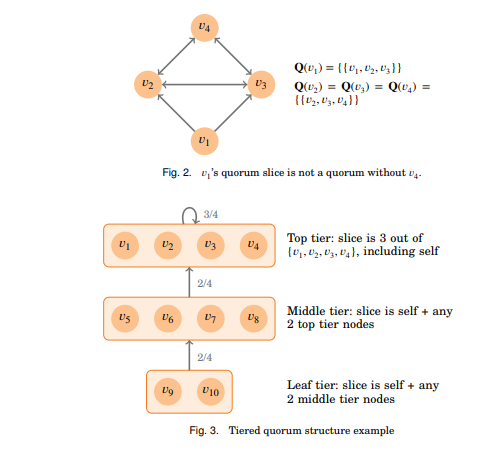
Consensus is reached through a multistage voting process. Nodes propose (nominate) statements (transactions), vote for and/or accept them, and then confirm the results of the nomination through a ballot when acceptance reaches the quorum threshold. Confirmed results are then written into the ledger and broadcasted over the network. It is possible for nodes to reach a stalemate during the ballot. To maintain liveliness of the network, a neutralization mechanism has been implemented. If, during a ballot over the value of a given slot, consensus becomes stuck, the nodes simply move to a higher round of ballot and vote again on the value of the slot. This function ensures that the system does not get stuck.
Conservatively, the network can process 1000 operations per second, with a confirmation time of 3-5 seconds, which compares very favorably to its competitors. The confirmation time lends itself especially well to use cases like payments, cross-border transactions at scale, and trading.
| Project Name | Ticker | Consensus Protocol | TPS | Time to Confirmation |
| Stellar | XLM | FBFT | 1000 ops | 5 sec |
| Ethereum | ETH | PoW | 25 tps | 6 min |
| Dash | DASH | PoW | 28 tps | 15 min |
| Waves | WAVES | LPoS | 100 tps | 10 min |
Stellar additionally enables the “freezing” of assets as a way for resolving conflicts. The ledger remains immutable, but the assets in question can only be sent back to the originator of the disputed transaction.
Stellar supports limited smart contracts. The smart contracts are not Turing complete, but allow for various constraints to be implemented, including: multi-signature, batching, sequence, and time bounds. Its ability to support smart contracts makes it more attractive than strictly payment focused projects and offers additional opportuneness (in the form of dApps) for the growth of the ecosystem.
Despite the early troubles, Stellar has matured from a technology perspective and is suitable for multiple use cases. After Stellar dealt with a ledger fork that arose in the early days and implemented the Stellar Consensus Protocol, there have not been any critical issues reported to date that would bring into question the security or stability of the network.
However, it is difficult to analyze the pace of development from a network perspective, as the nonprofit and for-profit branches appear to be developing solutions in parallel, with a limited number of updates for the community from the team.
Overall, the Stellar network appears to be on a solid technology footing with a relevant, scalable solution that addresses the key pain points of the industry.
Stellar Roadmap
The Stellar Development Foundation does not showcase a live tracker of its development progress. In the beginning of 2018, it released a roadmap for the year that featured:
- SDEX – Stellar Decentralized Exchange;
- Lightning Network on Stellar;
- Improving network resilience and security and making it easier to run a full validator node.
Separately, the team released a roadmap for the implementation of the Lightning Network.

On the Lightning front, things have been quiet for some time. While some news channels have interpreted the lack of news, as confirmation of the original December deadline, others within the community exhibited skepticism. The SDEX appears to be almost ready and is rumored to bring about an update that would restrict the user’s buy/sell activity to the amount of funds that his/her wallet holds.
Stellar also maintains a list of applications that need to be built as a way to guide community effort.
However, Interstellar has also been working on similar solutions, namely StellarX, a GUI for the trading environment, and Starlight. The roadmap for Starlight is not date specific; however, there has been some tangible progress made on this front.

In the short term, users might not care about who is developing the technology and how it is developed, as long as it gets pushed to the network in a timely and stable fashion. However, it is difficult to verify the precise role of the nonprofit organization, and more alarmingly, whether it is being used to prop up the for-profit one – something that would be considered an abuse of trust, at the very least, and could cause governance issues down the line.
Part Three: The Investment Case
XLM Token Performance
Stellar has been battling with EOS for a place in the top by market capitalization group. However, just like the rest of the industry the cryptocurrency has been weathering the effect of the ongoing bear market. Lumens have been down over 70% since the January ATH.
So, it is not surprising that the price comparison chart for Stellar and its rivals exhibits a similar set of shapes.
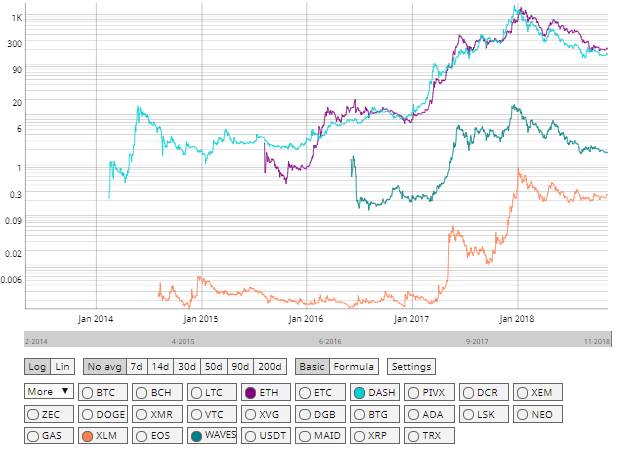
The vast majority of XLM trading is represented by XLM/BTC and XLM/USDT markets. However, the low levels of fiat volume are concerning. Given that Stellar is trying to make a play in the payment services space, it would help to see greater fiat volumes.
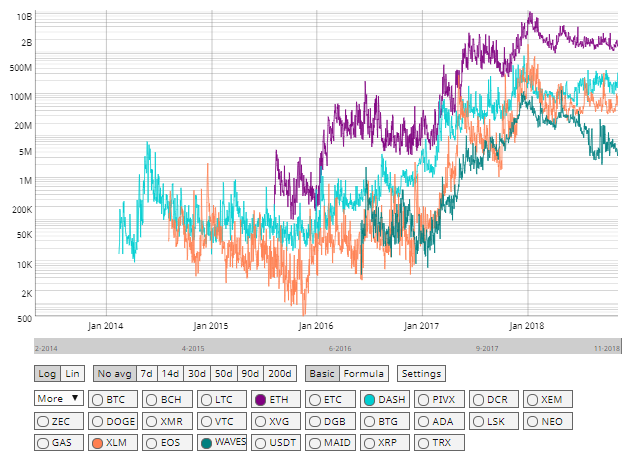
Volume has followed a similar pattern to price. While exchange volume has receded from January highs, Stellar remains a top 15 crypto-asset by volume.
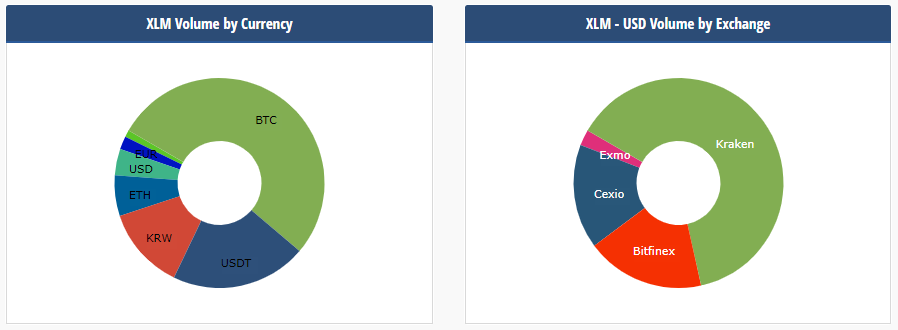
It is interesting to note that Stellar has stabilized volume numbers much better than Waves. With Waves being the most serious competitor to Stellar in the DEX sector, this could indicate a waning interest for the rival and an easier road ahead for Stellar in this space.
The bear market has also resulted in lower volatility (30-day) numbers. Interestingly, Stellar has displayed one of the strongest downtrends. While lower volatility is disadvantageous to traders, it makes adoption easier. Predictable prices mean predictable costs, which is important for real world use cases.
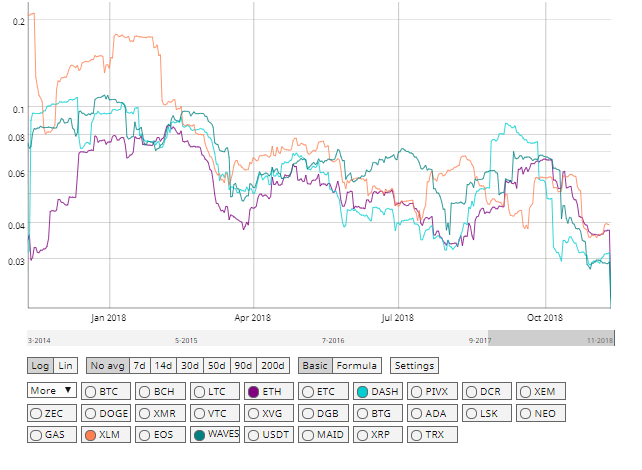
With ETH exhibiting a sinusoidal pattern over the year, XLM has been able to catch up in terms of volatility levels. This could give Stellar a boost in the dApps race as costs become an issue for developers and users.
Trending News
